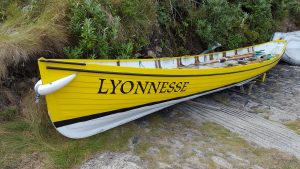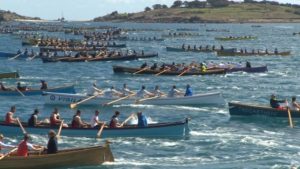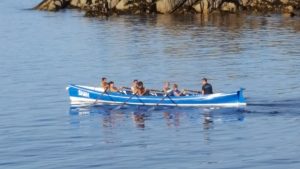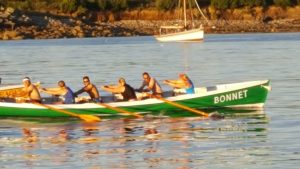This is a guest blog I wrote for Antoine Vanner’s Dawlish Chronicles – follow the link for the original in context. The part at the end where I talk about Dawlish refers to Antoine’s protagonist, Nicholas Dawlish, who is a Royal Naval officer in the latter part of the 19th century. I have reviewed several of his books before, and am looking forward to reading the latest, Britannia’s Amazon, available now in paperback and shortly in Kindle.
Antoine has kindly given me space today to talk about gigs and their use in south-west England, specifically the Scilly Isles and Cornwall. So far as I am aware these have never been used in war, but their history is no less exciting or varied for that.

First, what is a gig in this context? Picture something that looks roughly like a clinker-built rowing eight. Keel to gunwale depth is around two feet, and once crewed, the waterline is almost exactly at the mid-point. At 32′ long, just under 5′ beam, but with elm planks only 1/4″ thick, the boat is light enough that the crew can pick her up and carry her into the water. Many years of experience mean that a gig has been built robustly enough to take on the Atlantic swell, despite the apparent flimsiness.
Like an eight, each oarsman has a single oar, and they sit to row alternately port and starboard facing the cox’n. But curiously, they have only six rowers, reflecting part of their history. A mast and lugsail could be fitted if desired, though in commercial practice this was rarely done. They are fast, tough little boats, and at one stage played a crucial role in the economic livelihood of the islands. Today they have retired from commercial use, but have found a new lease of life in competitive sport. The annual world gig racing championship is held on Scilly every April/May. In 2016 it attracted more than 150 boats from many different countries.

We can trace the history of the gig back to 1666 at least, when vessels from St Mary’s were involved in rescuing the crew of the Royal Oak, wrecked out at what is now the Bishop Rock lighthouse. We have no reason to suppose there were not earlier vessels of essentially the same pattern. All modern gigs are based on the lines of an early 19th century design by William Peters. They had two principal uses, the main one being to get local pilots out to incoming ships as quickly as possible. Whoever got there first got the contract, hence the need for speed. Scilly was one of the major landmarks for vessels inbound from the western trade routes, but the seas are treacherous here, with countless rocks and reefs. Even with modern navigation aids they are hazardous: how much more so in former days? So families or village groups would aim to spot new arrivals as early as possible, and get out to them as quickly as possible.

The other use, more humanitarian than commercial, was as a kind of early lifeboat system. Gig crews over the years have saved a great many lives by going out – frequently in horrendous weather – to rescue crews and passengers suffering shipwreck. Cargo could also be brought back, and an 1887 rescue of 450 cattle from the Castleford involved lashing the animals’ heads and horns to the sides of the gigs Gipsy and O&M, and towing them to a handy nearby island! Such rescues were fearfully dangerous acts, and the churches on Bryher, St Agnes and elsewhere remember many who never returned.
Now, gigs came to the attention of the revenue authorities, who suspected that they had a third use – for smuggling. Certainly they would have been capable of it, with their proven seagoing capability. Even the Cornish coast was within a day from the Scilly Isles for a good crew – the 40-odd mile trip to Penzance typically takes under 10 hours, and Newquay was within comfortable reach. Gigs could easily make the 250-mile round trip to France’s Breton coast by staying out at sea for a day or so, and were robust enough to cope. Bonnet (of which more later) rode out a thirty-hour storm on one such trip by keeping head to wind until conditions improved. A good crew can sustain speeds of around 7 knots, but speeds of nearly 10 knots have been recorded over a measured mile with racing crews rowing at 40 strokes per minute. But therein lay a problem – an eight-oared gig was faster than the customs cutters of the time. This was clearly unacceptable, so a law was passed in 1829 limiting the crew to no more than six oars per boat.
Time passed, and both piloting and rescue ceased to be the responsibility of the islanders. The last recorded pilotage was in December 1938, when the Bryher boat Gipsy went out from St Agnes. As for rescue, the last known one was of the Panamanian steamship Mando in 1955. For a time, it seemed possible that gigs in the traditional sense would die out. Some of the older craft were laid up in storage, others suffered the usual fate of wooden boats which are not constantly cared for.

Then competitive racing emerged, giving a new lease of life to the design. Informal races had been part of gig culture for a long time: now it has become organised. Inter-island men’s, women’s and mixed races take place weekly during the tourist season, quite apart from the challengers coming from further afield. And here, the robust nature of the vessels is once again proved. Bonnet still races today – she was built in 1830 and had a long and busy working life. She is heavier than her modern siblings, but if there’s a bit of a sea this might not be a disadvantage. Back in August, I saw her beat a dozen other boats to win her race. The Cornish gig Newquay was built back in 1812, and is claimed to be the oldest ship afloat which is still being used for broadly the same purpose as when she was made. Appropriately, she is owned by the Newquay Rowing Club, who also look after Dove (1820) and Treffry (1838) – all still racing.
So, this brings us to Antoine’s own protagonist, the naval officer Nicholas Dawlish, and the timeline set out for his life. Bonnet had been working for 15 years when Dawlish was born in December 1845, and for over fifty years at the time of Britannia’s Spartan. There’s a fair chance that Newquay was built before Dawlish’s father was born. On the assumption that Dawlish passed the Scillies at some stage during early career – and it would be wildly improbable if he had not had cause to see them at close quarters – he would have seen gigs in active commercial use. I wonder, with his eye for design, if he took the time to appreciate their blend of speed, strength and elegance?
Finally, for those who want to look at videos, this video has the 2016 men’s final and lots of links to other clips:
